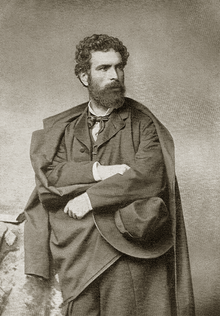art.wikisort.org - Artist
Nikolaos Gyzis (Greek: Νικόλαος Γύζης [niˈko.la.os ˈʝi.zis]; German: Nikolaus Gysis; 1 March 1842 – 4 January 1901) was considered one of Greece's most important 19th century painters. He was most famous for his work Eros and the Painter, his first genre painting. It was auctioned in May 2006 at Bonhams in London, being last exhibited in Greece in 1928. He was the major representative of the Munich School, the major 19th-century Greek art movement.
This article may be expanded with text translated from the corresponding article in Greek. (April 2014) Click [show] for important translation instructions.
|
Nikolaos Gyzis | |
|---|---|
 | |
| Born | 1 March 1842 Tinos, Greece |
| Died | 4 January 1901 Munich, German Empire |
| Nationality | Greek |
| Education | School of Arts, Athens Royal Academy of Fine Arts, Munich |
| Known for | Painter and faculty member |
| Movement | Orientalist Munich School Genre art |
Life

Gyzis was born in the village of Sklavochori, on the island of Tinos which has a long artistic history. As his family settled in Athens in 1850, he soon embarked on a study at the Athens School of Fine Arts. His studies there formed the foundation of his artistic education and helped him to develop his natural skill in painting.
In 1865, having won a scholarship, he went to continue his studies at the Academy of Fine Arts, Munich, where he settled for the rest of his life. He was very soon incorporated into the German pictorial climate, and became one of its most characteristic representatives of the Greek artistic movement of the Munich School. This is expressed in the painting News of Victory of 1871, which deals with the Franco-Prussian War, and the painting Apotheosis i Thriamvos tis Vavarias (Apotheosis or Triumph of Bavaria).
From 1886 onward he was professor at the Academy of Fine Arts, Munich, and gradually turned from the detailed realistic depictions towards compositions of a singularly impressionistic character. His students included Jan Vochoc, Ernst Oppler, Fritz Osswald, Anna May-Rychter,[1] and Stefan Popescu (Romanian painter).
At the beginning of the 1870s returned to Greece for a period of several years, after which he produced a sequence paintings with more avowedly Greek themes, such as the Carnival at Athens and the Arravoniasmata (Engagement Ceremony) and a little later the painting After the Destruction of Psara. Towards the end of his life, in the 1890s, he took a turn toward more religious themes, with his best known work of the later period being Triumph of Religion.[2] Gyzis died in Munich.
Legacy
His works are today exhibited at museums and private collections in Greece, Germany, and elsewhere.
Gyzis' painting The Secret School was depicted on the reverse of the Greek 200 drachmas banknote of 1996–2001.[3]
The Athenian neighbourhood Gyzi is named for him.
Gallery
 Ηistoria (1892)
Ηistoria (1892)- Capuchin monk
- Eros and the Painter
- Learning by Heart
- The Barber (1880)
- After the destruction of Psara
- The orphans
- Oriental man with pipe
- Artist's psyche
- Oriental Warrior
- Old man wearing a red fez
- Peek-a-Boo (1882)
- Girl Playing (1868)
- Pastryman
- The Glory of Psara
See also
- Munich School
- National Gallery of Athens
- Art in modern Greece
- Greek Art
- Emfietzoglou Gallery
References
- Hammersite Auction House
- NCAW Autumn 02 | Antonis Danos on Nikolaos Gyzis's The Secret School
- Bank of Greece Archived March 28, 2009, at the Wayback Machine. Drachma Banknotes & Coins: 200 drachmas. – Retrieved on 27 March 2009. Archived March 6, 2009, at the Wayback Machine
External links
- Nikolaos Gyzis's The Secret School and an Ongoing National Discourse by Antonis Danos
- National Gallery of Greece
- Gallery of Paintings by Nikolaos Gyzis
На других языках
[de] Nikolaus Gysis
Nikolaus Gysis oder Nikolaos Gyzis (griechisch Νικόλαος Γύζης, * 1. März 1842 in Sklavochori auf Tinos, Griechenland; † 4. Januar 1901 in München) war ein griechischer Genre- und Monumentalmaler, der die meiste Zeit seines Lebens und Schaffens in Deutschland verbrachte.- [en] Nikolaos Gyzis
[es] Nikolaos Gyzis
Nikolaos Gyzis en griego, Νικόλαος Γύζης (pronunciado /jíʑiɕ/); Tinos, 1 de marzo de 1842 - Múnich, 4 de enero de 1901) fue un pintor griego del siglo XIX, en la cabeza de la llamada ‘escuela de Múnich’.[fr] Nikólaos Gýzis
Nikólaos Gýzis (en grec moderne : Νικόλαος Γύζης) est un peintre grec né à Sklavochóri sur Tinos le 1er mars 1842 et mort le 4 janvier 1901.[it] Nikolaos Gysis
Nikolaos Gysis (in greco: Νικόλαος Γύζης, pron. [niˈkolaos ˈʝizis]; Tinos, 1º marzo 1842 – Monaco di Baviera, 4 gennaio 1901) è stato un pittore greco.[ru] Гизис, Николаос
Николаос Гизис (греч. Νικόλαος Γύζης; 1 марта 1842 (1842-03-01), Склавохорио, остров Тинос — 4 января 1901, Мюнхен) — один из наиболее известных греческих художников XIX столетия. Живописец и график академического направления.Другой контент может иметь иную лицензию. Перед использованием материалов сайта WikiSort.org внимательно изучите правила лицензирования конкретных элементов наполнения сайта.
WikiSort.org - проект по пересортировке и дополнению контента Википедии















